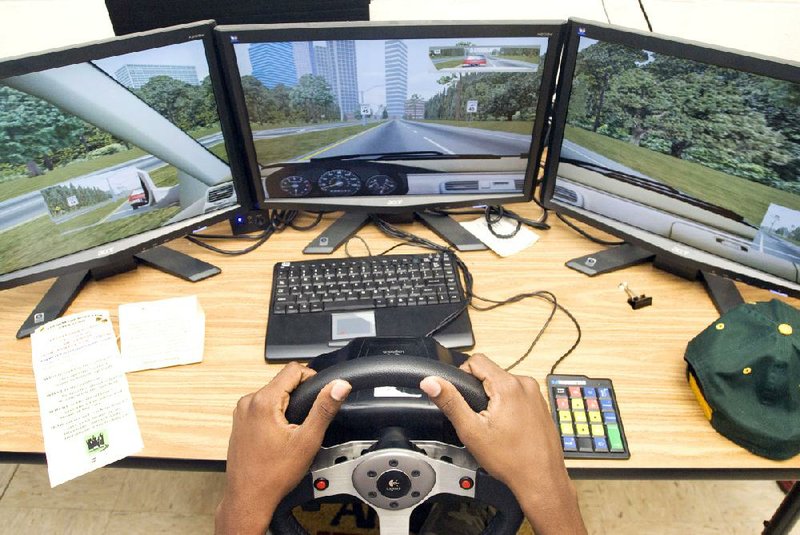LITTLE ROCK — Thirteen-year-old Deion Dobbins is barely on his way, driving for the first time, when the worst happens. Wham! He hits another car. “I never saw it coming,” Deion admits with a grin, the wreck being just a video gamelike computer simulation. The serious part is the lesson he will take away from this experience, part of a two-day driver education class at the Jim Wetherington Boys & Girls Club in North Little Rock.
“You shouldn’t have any distractions when you’re driving,” Deion says. “You shouldn’t be shoutin’ out the window. You need to pay attention.”
He could have said the test wasn’t fair — could have blamed the mistake on his teenage classmates, the way they crowded around the driving simulator. Nine of them, all telling him how to drive. No wonder he crashed.
But they, too, were part of the simulation. They were acting like passengers. The class teaches that passengers can be a dangerous distraction, and the driver’s job is to pay attention to his driving, anyway.
Next time, Deion says, he will focus more on the rules of safe driving. The class teaches students to keep checking the side mirrors, to use turn signals, to make sure the car has enough gas.
The class is called UPS Road Code, part of a national program offered in 52 boys and girls clubs in 36 American cities through the UPS (United Parcel Service) Foundation. UPS package deliverymen drive 3 billion miles a year, and the company says they average fewer than one accident per million miles.
“We’re teaching you what we go back and teach our drivers,” Sherry Edwards tells the class, also taught by UPS supervisor David Dale.
Dale’s job includes training the company’s professional drivers, some of whom, he says, “come with bad habits they learned when they were 16 or 17.”
“I wish I could have learned this way,” he says of the classes taught by UPS volunteers. The Jim Wetherington Boys & Girls Club was among the first to start the program three years ago.
“It really opens their eyes to what it takes to drive,” says Bud McGinnes, director of the club near downtown North Little Rock, a unit of the Boys and Girls Club of Central Arkansas. “We run about 100 teens a year through this program,” McGinnes says — club members like Steven Tate, 15, who sign up for the training. Steven is three years away from having a full-fledged driver’s license, but he can hardly wait. “I’m ready,” he says. “I’m really ready.” Enthusiasm helps, but the simulator is another way to see who might be good to go.
CAUTION: ROAD WORK
The class starts with desk work that leads to drills and a final exam. “Always wear your — what?” Edwards prompts the class. “Seat belt,” they answer. “Look over your left — what?” “Shoulder.”
“What’s a stale green light?” she asks. Anybody? “It’s a light that you did not see turn green,” she says, which means the light might be just about to turn yellow.
The simulator is three computer screens on a tabletop, arranged in a semicircle to duplicate a driver’s wrap-around view ahead and to either side. The steering wheel attaches to the front of the table. The pedals — gas and brake — mimic the experience of driving an automatic shift.
Traffic passes. Stoplights turn red. Bicyclists veer into the street. A built-in voice plays the role of a no-nonsense driving instructor, issuing directions:
“Stay in your lane. Do not stray.”
“Turn off the windshield wipers. Put your right foot on the brake pedal. Put the car in drive.”
“You have been speeding. You will be disqualified if you commit a second offense.”
Edwards says the class reminds her of what a complicated thing driving is, and she thinks of this on her drive to the youth club. Driving skills settle into habit and routine, but driving to class reminds her to be extra vigilant.
“It’s scary, some of the things people do,” she tells the class. “You have to expect the unexpected.”
For completing the lessons, each student receives a certificate, T-shirt and tote bag — not a driver’s license, not yet, but their time will come.
“This is important,” she tells the class, hoping they will put these lessons to use.
Deion, for one, has learned just how to advise the next guy to try the driving simulator. He speaks up even before the computer voice objects to the beginner’s weave-and-wobble performance:
“Hey! Stay in your lane!”
Family, Pages 34 on 07/18/2012

